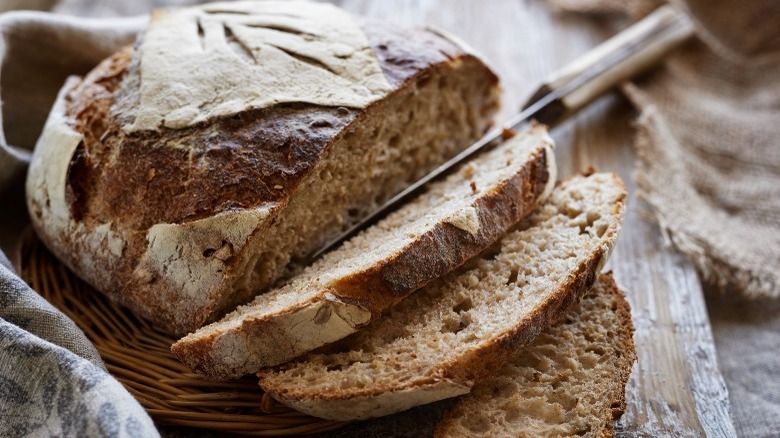Health Experts Suggest This Is The Healthiest Type Of Bread
If you love eating bread, you're not alone. Consumption of bread in the United States has steadily increased since 2011. By 2020, over 326 million Americans reported that they used bread, according to Statista. And like your favorite bread, that number is expected to rise. Data predictions indicate that over 335 million Americans will be using bread in 2024.
While there will be some variation in the number of ingredients in bread depending on the recipe, there are four essential components: flour, yeast, salt, and water, according to the Federation of Bakers. Wheat flour is the most common type of flour used in bread; once the flour is moistened and kneaded, gluten forms and provides the bread dough with elasticity. Yeast is what enables the bread dough to rise and also gives bread its familiar taste and aroma. Salt gives additional flavor and also supports the gluten in giving the bread greater texture and volume. When used in the proper amounts, water, the fourth key ingredient, helps to evenly disperse all the other ingredients.
Many experts believe that bread was first produced in Neolithic times, when humans began to cultivate the land (via Brittanica). Egyptians eventually advanced the process by discovering ways to ferment bread and also developed baking bread in ovens. Given that basic bread requires only a few fundamental natural ingredients, it makes sense that it's been a central food in the human diet for thousands of years.
Choose this type of bread for the most health benefits
Bread continues to be a key dietary component due to the vitamins, minerals, carbohydrates, and fiber it provides. However, not all the different kinds of breads produced today will contain the same health benefits.
For instance, while carbohydrates are important in providing the body with fuel, the experts at Medical News Today point out that the carbohydrates in white bread are highly processed. Consequently, white bread typically contains less fiber than healthier breads, can lead to weight gain, and can also cause your blood sugar to spike, which can increase your risk of developing type 2 diabetes.
Among the healthier alternatives, the experts at Healthline suggest you eat sprouted breads. Most are high in protein and fiber and are less likely to impact your blood sugar, which is why sprouted bread is a good choice for people with type 2 diabetes. Another healthful choice is 100% whole wheat bread, which retains the entire grain, making whole wheat bread higher in fiber than bread made with refined flour. And if you like a little tang, sourdough bread is another healthy option. The naturally-occurring yeast and bacteria in both white and whole-wheat sourdough undergo a fermenting process that studies suggest may help your body absorb vitamins and minerals more effectively. Sourdough also contains probiotics, which can help you maintain a healthy gut. While both white and whole-wheat sourdough are healthy, go for the whole-wheat version for maximum nutrients, per Healthline.


